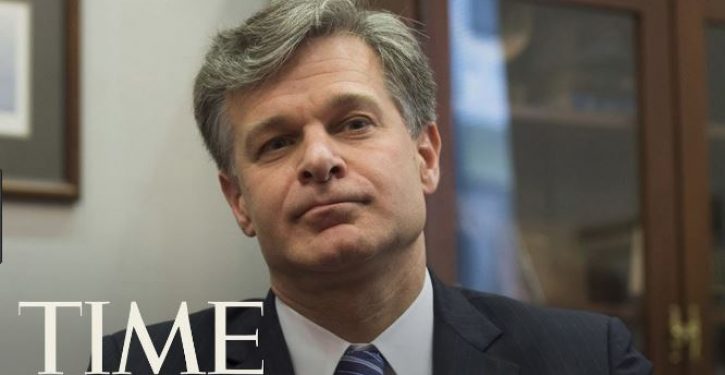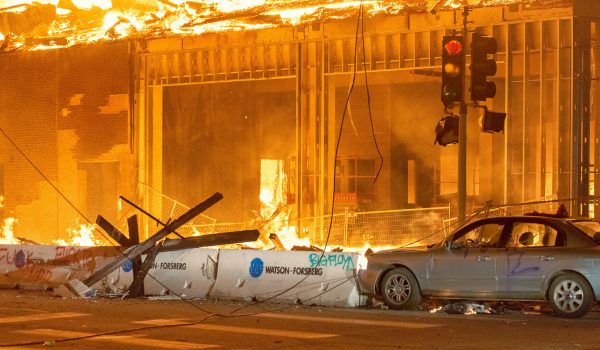
At a hearing of the Senate Homeland Security Committee last week, FBI Director Christopher Wray said juvenile offenders are contributing to a spike in violent crime, which rose substantially from 2020 to 2021. There are “too many dangerous offenders getting back out on the streets,” and there has been “an alarming uptick in the incidents of juveniles engaging in violence, often graduating from carjackings to even worse violence.” This uptick can result from “prosecution practices, certain kind of bail practices,” and the failure to “effectively deal with crimes committed by minors.”
Senator Jon Ossoff (D-GA) had asked him, “What is driving this dynamic?”
In response, Wray said,
“So, there are a lot of things driving the violent crime crisis that is occurring in this country, in Georgia and elsewhere…First, I would say the traditional drivers are all there, drugs, illegal gun trafficking, gangs, socioeconomic factors. So, those are all still present.
“But in addition to that, we are seeing, and I hear this from chiefs and sheriffs all the time as well as from our own agents, an alarming uptick in the incidents of juveniles engaging in violence, often graduating from carjackings to even worse violence. And that is a real challenge for the legal system, because we’re not set up to very effectively deal with crimes committed by minors.
“We are also seeing — not everywhere but an awful lot of places, we are seeing way too many dangerous offenders getting back out on the streets. And the only thing more frustrating to the hardworking men of law enforcement than having to arrest somebody who should have been behind bars is having to arrest the same person over and over again.
“And that’s a product of any number of things. It could be backlogs. It could be certain prosecution practices, certain kind of bail practices, and of course the juvenile issues that I mentioned. So, those are some of the things that are driving it.
“In Georgia in particular, pretty much every week, I feel like our Atlanta field office is engaging in some kind of operation where they’re seizing drugs, guns, cash, whether it’s meth, whether it’s fentanyl. And so, they’re experiencing a lot of the same things that we’re seeing nationally.
“Certainly, neighborhood gangs are a big phenomenon in our home state. We are also seeing — I would add two other things that have a little bit of a Georgia wrinkle to it. One is juveniles who, post-COVID, have not returned to school, and so that may contribute to the juvenile effect.
“And we’re seeing, you know, violent criminals who are either detained or imprisoned because they’re serving a sentence who still have access to their cellular phones and are able to continue to participate in the activity — despite best efforts by the corrections officials, to continue to participate in the violent activities.”
Teenage criminals face much milder penalties than adult criminals do, especially due to recent criminal justice “reforms.”
Some progressive prosecutors have reduced penalties for crimes by teenagers by refusing to try people who committed violent crimes at age 16 or 17 in adult court, even when they commit murder, robbery, or rape. So violent teens — even teenage serial killers — will not be held beyond age 25 in these jurisdictions, no matter how many people they kill, or how much harm they cause. Most are released before age 21. Such short sentences result in higher juvenile crime rates and higher recidivism rates among juvenile offenders. As Peter Moskos notes, “Recidivism among 16-year-olds went up” when the age for being prosecuted in adult court was raised in New York. The recidivism rate for 16-year-olds rose from 39% to 48% for offenses generally, and from 18% to 27% for violent felony offenses.
Left-wing prosecutors are also refusing to seek sentence enhancements mandated by state law, such as the longer sentences required for repeat offenders. Studies indicate that longer periods of incarceration deter many crimes from being committed by people who are not currently incarcerated; they don’t merely prevent people who are already inmates from committing more crimes — although they do that, too. For example, a study found that longer sentences deterred people from committing murder, robbery, and rape. (See Daniel Kessler & Steven J. Levitt, Using Sentence Enhancements to Distinguish Between Deterrence and Incapacitation, National Bureau of Economic Research Working Paper #6484 (1998)).
A 2008 Santa Clara University study found that longer sentences for three-time offenders led to “significantly faster rates of decline in robbery, burglary, larceny, and motor vehicle theft,” even after controlling for pre-existing crime trends and economic, demographic, and policy factors.
Maryland and Virginia are alike in many ways. But Maryland has shorter sentences for criminals than Virginia. It also has a violent crime rate more than double Virginia’s. In 2018, Maryland had a violent crime rate of 468.7 per 100,000 people, according to USA Today, compared to a violent crime rate of only 200 per 100,000 in Virginia.
Carjackings by teens have spiked in cities across the country over the past two years. NewsNation describes the “nationwide rise in carjackings”:
A pastor gunned down in a carjacking outside her home in Memphis. A thief runs up a driveway with a weapon drawn in New Orleans. An Atlanta mother of three, tossed out of her car and run over with it — all captured on her own Ring camera…Over the last two years, there has been a noticeable uptick in carjackings nationwide...
Chicago — a city with 40 cops on a carjacking task force —had more than 1,900 last year. That number is the most in the country and the most in the Windy City in decades…
And some of the perpetrators are shockingly young.
The pastor killed in Memphis was shot by a 15-year-old. In D.C, a 14-year-old was arrested for jacking six vehicles and trying to take a seventh.
Washington, D.C., reported 426 carjackings in 2021, up from 142 in 2019. This March, a Washington doctor was run over and killed by a carjacker who drove off in his car. Last March, two teenage girls aged 13 and 15 carjacked and killed an Uber Eats Driver in Washington, DC, a crime for which they received only juvenile detention, not prison.



